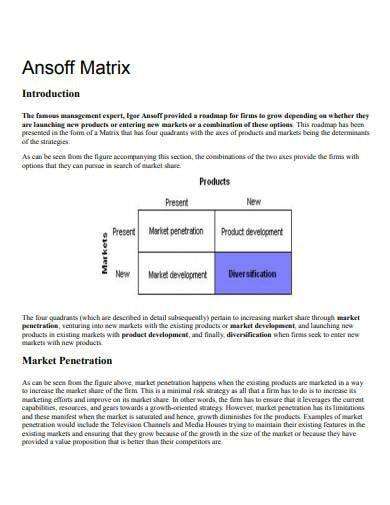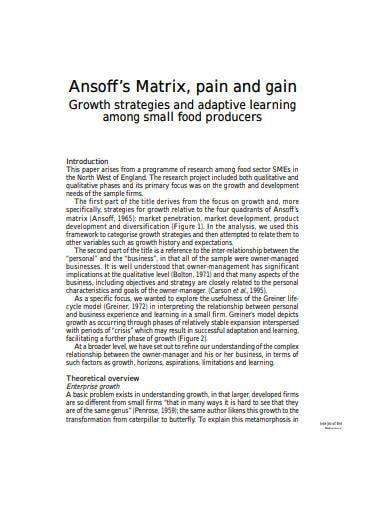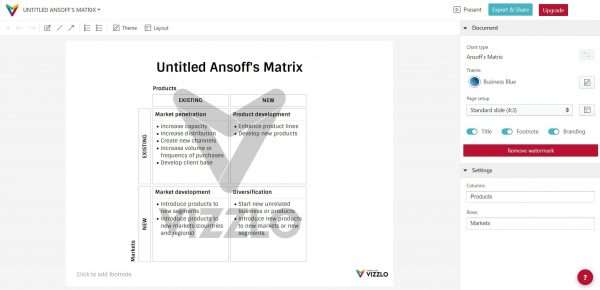The Ansoff matrix template is a two-by-two grid that is used by top executives and analysts to organize and assess growth initiatives. It is also referred to as The “Product/Market Expansion Grid” at times. The tool helps stakeholders, in particular, figure out how risky different kinds of development projects are.
H. Igor Ansoff, an applied mathematician, and the manager invent this matrix. It was then published in the Harvard Business Review in 1957. The Ansoff Matrix is often used with other industry and business research techniques to provide more extensive analyses of the elements fresh impacting company growth. These tools include the SWOT, PESTEL, and Porter’s Five Forces frameworks.
The matrix can be a great way to explain strategies or help people talk together during a presentation. One of the most important benefits is that it shows visually how the risks change when you choose one approach over another.
Here is a brief explanation of each of the Ansoff Matrix Model’s four quadrants:
- Market penetration: It is about the concept of increasing sales of products that are already on the market.
- Market development: It seeks to market existing products in new emerging markets.
- Product Development: This process is concerned with introducing new items to the market.
- Diversification: The goal of diversification is to provide whole new products to a new market.
How to Use Ansoff Matrix
Market Penetration, Market Development, Product Development, and Diversification are the four quadrants that make up an Ansoff matrix. The framework should also show how new and old goods and new and old markets fit together in each quadrant.
You can make both virtual and real copies using any method you like, such as whiteboards, paper, slideshows, and more. Another excellent option is to use mapping software like ClickUp. These programs have features like the ability to edit and Ansoff matrix templates that make it easier to make and use your matrix.
Ansoff Matrix Template Google Docs
Comprehensive understanding of the Ansoff matrix
When you utilize an Ansoff matrix, then you and the executive team will think about the risks, questions, and opportunities under four different categories. These categories are product development, market development, market penetration, and diversification.
These categories comprise the four quadrants of the matrix, as shown by the example. Entering a new region, whether it’s horizontally or vertically, makes the proposed activities riskier. Market penetration is the least risky solution, whereas diversification is the riskiest.
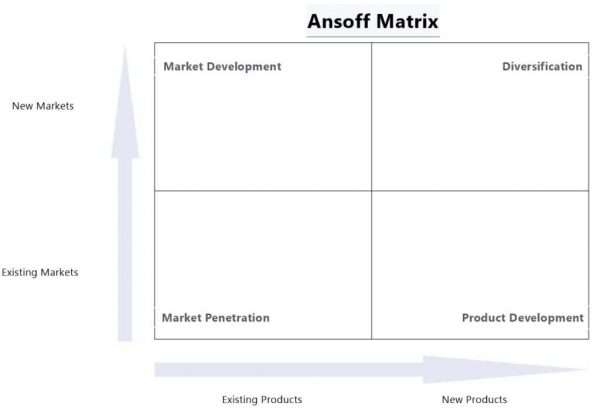
Let’s delve a little deeper into each of these quadrants.
Market Penetration
When a market penetration strategy is used, the company tries to sell more of its existing products in markets where it already has relationships and is known. Typical methods of execution include
- Increasing marketing efforts or streamlining distribution methods
- Price reductions throughout the industry to attract new customers.
- Acquiring a competitor in a comparable market
Let’s take the example of a company that provides packaged products for consumers to a large number of grocery stores. The management of a large chain may change the prices of its pet food and packaged foods in order to reach more people and get more shelf space.
Ansoff Matrix Template Excel
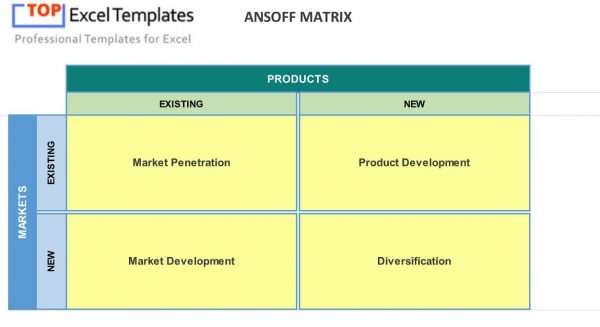
Market Development
This strategy is the second least riskiest, since it does not need a huge amount of capital for R&D or the creation of new products. Instead, it allows an executive team to enter a new market using existing products. Techniques include
- Serving a separate customer base or target market, a new domestic
- Launching a new venture domestically for regional expansion
- Introducing a global market for international expansion
Think about a company like Lululemon, whose leaders decided to move quickly into the market of Asia-Pacific to sell their already popular athleisure clothing. There are risks involved in logistics infrastructure and building marketing for the international market, but those risks are lessened by the fact that they are promoting a product with a clear path.
Product Development
This strategy type is used when a business is able to get the attention of its target market. It may then make an effort to boost its share of consumer spending among that group. In this market, businesses generally rely on customer loyalty, which may be acquired in a number of methods, including
- Investing a lot of money into R&D to create new items
- Obtaining the right to manufacture and commercialise a product developed by another company.
- To brand an item under a white label that was actually manufactured by a third-party provider and launch it as your own fresh produce.
For instance, a cosmetics manufacturer and retailer of hair care items targets women between the ages of 28 and 35. They put a lot of money into making a brand-new collection of hair care items so that they could take advantage of how well-known and loved the brand is among this group and hope that the current target market will like it.
Ansoff Matrix Template Word
Diversification
Diversification is often the riskiest thing to do because it requires both market development and product development. Even though this is the riskiest strategy, it could pay off in a big way by opening up new ways to make money or by making a company less dependent on a single product or market.
There are two primary kinds of diversification strategies that a management team may consider:
1. Related Diversification
“Related diversification” is the term for when a company gets into a new business that has a lot in common with its current business or industries.
For instance, consider a company that typically makes leather shoes but has decided to start producing leather car seats. Even though both research and development (R&D) and production (making the product) will require a lot of money, there is almost certainly an advantage to be found in the procurement of the raw materials.
2. Unrelated Diversification
When a business ventures into an industry that has little to no connection to its existing industry or industries, this is known as “unrelated diversification.”
Let’s take the example of a leather shoe manufacturer again. For example, their management has decided to invest more quickly in packaged goods for their customers in order to broaden the company’s offerings and make it less reliant on high-end shoes.
Advantages and Disadvantages Ansoff matrix
Here is a quick list of some good things about the Ansoff Matrix Model and some bad things about it:
Advantages
- Excellent tool for visual presentations.
- well suited to companies that concentrate on products.
- essential to considering internet of things (IoT) projects.
- Facilitates understanding and discussion of the risk posed by different solutions.
Disadvantages
- Not very agile; more relevant when examining sectors than venues.
- Short-term adaptation to lean innovation conditions may be difficult.
- focuses less on customer experience and instead adopts a more broad, demographic approach to the market.
- Gray areas are difficult to visualize.
A Five-Step Guide to Draw and Use the Ansoff Matrix
Follow these instructions to draw your diagram:
1. Build your matrix.
Create your grid as previously mentioned, using the tools of your choosing. The greatest and simplest solution for saving time and effort is to use templates. Despite being crucial, this stage shouldn’t take too long to accomplish.
2. Evaluate your options
After that, map out possible methods for each quadrant. Think about how you can expand the business in a realistic manner. Don’t restrict your thinking, but do be realistic about each idea’s likelihood of success. Consider broad and audacious ideas.
3. Perform a risk analysis.
The key idea of the Ansoff matrix is understanding the dangers. You might find out how you are putting your business at risk and what problems might come up if you use a risk/reward matrix template. Another option is to rank them according to relevance using a risk-impact or probability chart.
4. Make a risk management plan
Now that you know what the possible risks are, you should make backup plans to deal with them. Focus on the threats with the greatest likelihood and severity.
Ansoff Matrix Template Google Slides
Actions for Project Managers
The Ansoff matrix is a great tool for project managers to use when planning and carrying out projects.
- Portfolio management: The Ansoff matrix assists in making decisions about which projects will support growth plans.
- Planning: The matrix technique helps make the objectives of your project more obvious.
- Awareness: The Ansoff matrix may frame the company’s, its rivals’, and its suppliers’ plans.
- Professional development: The framework makes strategic thinking more understandable.
- Applied to risk management: It helps project managers understand the risks that come with different kinds of initiatives, including the risks of inaction.
5. Choose your strategy.
After going through these steps, you should be able to figure out which growth strategy is best. Take this course of action and begin preparing for its implementation!
Ansoff Matrix Template Online Tools
Ansoff Matrix FAQs
What are the 4 strategies of Ansoff Matrix?
The four strategies are market penetration, product development, market development, and diversification.
Which of the 4 strategies of the Ansoff Matrix is considered the riskiest?
The Ansoff Matrix’s riskiest strategic choice is diversification. It’s a plan that completely changes the way an organization works by putting its products in completely new markets.
How is Ansoff Matrix used?
In the strategy phase of the marketing planning process, the Ansoff matrix is used. It is utilized to determine the overall business strategy, and then it is used to figure out the best ways to market the business.








